Coarse Technogenic Material in Urban Surface Deposited Sediments (USDS)
Abstract
1. Introduction
2. Materials and Methods
2.1. The Description of the Studied Cities
2.2. Sample Collection
2.3. Particle Size Analysis
2.4. Mineral Analysis
3. Results
4. Discussion
- -
- the errors of the operator in identifying the particle type;
- -
- particle loss in particle size analysis under water washing and decantation;
- -
- counting errors in the analysis of heavy mineral concentrate;
- -
- the location of sampling sites in residential blocks far from roads, etc.
5. Conclusions
Author Contributions
Funding
Institutional Review Board Statement
Informed Consent Statement
Data Availability Statement
Acknowledgments
Conflicts of Interest
References
- Yarmoshenko, I.; Malinovsky, G.; Baglaeva, E.; Seleznev, A. A Landscape Study of Sediment Formation and Transport in the Urban Environment. Atmosphere 2020, 11, 1320. [Google Scholar] [CrossRef]
- Taylor, K. Urban environments. In Environmental Sedimentology; Perry, C., Taylor, K., Eds.; Wiley-Blackwell: Hoboken, NJ, USA, 2007; pp. 190–222. [Google Scholar]
- Sevilla, A.; Rodríguez, M.L.; García-Maraver, Á.; Zamorano, M. An Index to Quantify Street Cleanliness: The Case of Granada (Spain). Waste Manag. 2013, 33, 1037–1046. [Google Scholar] [CrossRef] [PubMed]
- Bartolozzi, I.; Baldereschi, E.; Daddi, T.; Iraldo, F. The Application of Life Cycle Assessment (LCA) in Municipal Solid Waste Management: A Comparative Study on Street Sweeping Services. J. Clean. Prod. 2018, 182, 455–465. [Google Scholar] [CrossRef]
- Russell, K.L.; Vietz, G.J.; Fletcher, T.D. A Suburban Sediment Budget: Coarse-grained Sediment Flux through Hillslopes, Stormwater Systems and Streams. Earth Surf. Process. Landf. 2019, 44, 2600–2614. [Google Scholar] [CrossRef]
- Polukarova, M.; Markiewicz, A.; Björklund, K.; Strömvall, A.-M.; Galfi, H.; AnderssonSköld, Y.; Gustafsson, M.; Järlskog, I.; Aronsson, M. Organic Pollutants, Nano- and Microparticles in Street Sweeping Road Dust and Washwater. Environ. Int. 2020, 135, 105337. [Google Scholar] [CrossRef] [PubMed]
- Muthusamy, M.; Tait, S.; Schellart, A.; Beg, M.N.A.; Carvalho, R.F.; de Lima, J.L.M.P. Improving Understanding of the Underlying Physical Process of Sediment Wash-off from Urban Road Surfaces. J. Hydrol. 2018, 557, 426–433. [Google Scholar] [CrossRef]
- Butler, D.; Davies, J.W. Urban. Drainage, 3rd ed.; Spon Press: London, UK, 2011. [Google Scholar]
- Murakami, M.; Fujita, M.; Furumai, H.; Kasuga, I.; Kurisu, F. Sorption Behavior of Heavy Metal Species by Soakaway Sediment Receiving Urban Road Runoff from Residential and Heavily Trafficked Areas. J. Hazard. Mater. 2009, 164, 707–712. [Google Scholar] [CrossRef] [PubMed]
- Grant, S. A Review of the Contaminants and Toxicity Associated with Particles in Stormwater Runoff; California Department of Transportation: Sacramento, CA, USA, 2015. [CrossRef]
- Knox, E.G.; Bouchard, C.E.; Barrett, J.G.; Brown, R.B.; Huddleston, J.H.; Anderson, J.L. Erosion and Sedimentation in Urban Areas. Agronomy Monographs 2015, 179–197. [Google Scholar] [CrossRef]
- Hewett, C.J.M.; Simpson, C.; Wainwright, J.; Hudson, S. Communicating risks to infrastructure due to soil erosion: A bottom-up approach. Land Degrad. Dev. 2018, 29, 1282–1294. [Google Scholar] [CrossRef]
- Vlasov, D.; Kasimov, N.; Eremina, I.; Shinkareva, G.; Chubarova, N. Partitioning and solubilities of metals and metalloids in spring rains in Moscow megacity. Atmospheric Pollut. Res. 2021, 12, 255–271. [Google Scholar] [CrossRef]
- Volpov, E.; Kishcha, P. An advanced technique for outdoor insulation pollution mapping in the israel electric company power grid. IEEE Trans. Dielectr. Electr. Insul. 2017, 24, 3539–3548. [Google Scholar] [CrossRef]
- Breault, R.F.; Smith, K.P.; Sorenson, J.R. Residential street-dirt accumulation rates and chemical composition, and removal efficiencies by mechanical-and vacuum-type sweepers, New Bedford, Massachusetts, 2003–2004. Sci. Investig. Rep. 2005, 27. [Google Scholar] [CrossRef]
- Nawrot, N.; Wojciechowska, E.; Rezania, S.; Walkusz-Miotk, J.; Pazdro, K. The effects of urban vehicle traffic on heavy metal contamination in road sweeping waste and bottom sediments of retention tanks. Sci. Total. Environ. 2020, 749, 141511. [Google Scholar] [CrossRef] [PubMed]
- Golokhvast, K.S.; Soboleva, E.V.; Borisovsky, A.O.; Khristoforova, N.K. Composition of atmospheric suspensions of Ussuriisk City according to snow pollution. In Proceedings of the 20th International Symposium on Atmospheric and Ocean Optics: Atmospheric Physics, Novosibirsk, Russia, 23–27 June 2014; Volume 9292, p. 929242. [Google Scholar]
- Hwang, H.-M.; Fiala, M.J.; Park, D.; Wade, T.L. Review of pollutants in urban road dust and stormwater runoff: Part 1. Heavy metals released from vehicles. Int. J. Urban. Sci. 2016, 20, 334–360. [Google Scholar] [CrossRef]
- Yu, B.; Lu, X.; Fan, X.; Fan, P.; Zuo, L.; Yang, Y.; Wang, L. Analyzing environmental risk, source and spatial distribution of potentially toxic elements in dust of residential area in Xi’an urban area, China. Ecotoxicol. Environ. Saf. 2021, 208, 111679. [Google Scholar] [CrossRef] [PubMed]
- Chang, X.; Li, Y.-X. Lead distribution in urban street dust and the relationship with mining, gross domestic product GDP and transportation and health risk assessment. Environ. Pollut. 2020, 262, 114307. [Google Scholar] [CrossRef] [PubMed]
- Lanzerstorfer, C. Heavy metals in the finest size fractions of road-deposited sediments. Environ. Pollut. 2018, 239, 522–531. [Google Scholar] [CrossRef]
- Seleznev, A.A.; Yarmoshenko, I.V.; Malinovsky, G.P. Urban geochemical changes and pollution with potentially harmful elements in seven Russian cities. Sci. Rep. 2020, 10, 1–16. [Google Scholar] [CrossRef]
- Seleznev, A.; Yarmoshenko, I.; Malinovsky, G.; Ilgasheva, E.; Baglaeva, E.; Ryanskaya, A.; Kiseleva, D.; Gulyaeva, T. Snow-dirt sludge as an indicator of environmental and sedimentation processes in the urban environment. Sci. Rep. 2019, 9, 1–12. [Google Scholar] [CrossRef]
- Seleznev, A.A.; Yarmoshenko, I.V.; Malinovsky, G.P. Assessment of Total Amount of Surface Sediment in Urban Environment Using Data on Solid Matter Content in Snow-Dirt Sludge. Environ. Process. 2019, 6, 581–595. [Google Scholar] [CrossRef]
- Seleznev, A.A.; Yarmoshenko, I.V. Study of urban puddle sediments for understanding heavy metal pollution in an urban environment. Environ. Technol. Innov. 2014, 1–2, 1–7. [Google Scholar] [CrossRef]
- Gunawardana, C.; Goonetilleke, A.; Egodawatta, P.; Dawes, L.; Kokot, S. Source characterisation of road dust based on chemical and mineralogical composition. Chemosphere 2012, 87, 163–170. [Google Scholar] [CrossRef] [PubMed]
- Magiera, T.; Górka-Kostrubiec, B.; Szumiata, T.; Wawer, M. Technogenic magnetic particles from steel metallurgy and iron mining in topsoil: Indicative characteristic by magnetic parameters and Mössbauer spectra. Sci. Total. Environ. 2021, 775, 145605. [Google Scholar] [CrossRef] [PubMed]
- Seleznev, A.; Pankrushina, E.; Ilgasheva, E. Do the contemporary urban surface sediments contain particles of microplastic? In Proceedings of the VII International Young Researchers’ Conference Physics, Technology, Innovations (PTI-2020), Ekaterinburg, Russia, 8–22 May 2020; Volume 2313, p. 060040. [Google Scholar]
- Hui, N.; Parajuli, A.; Puhakka, R.; Grönroos, M.; Roslund, M.I.; Vari, H.K.; Selonen, V.A.; Yan, G.; Siter, N.; Nurminen, N.; et al. Temporal variation in indoor transfer of dirt-associated environmental bacteria in agricultural and urban areas. Environ. Int. 2019, 132, 105069. [Google Scholar] [CrossRef]
- Bućko, M.S.; Mattila, O.-P.; Chrobak, A.; Ziółkowski, G.; Johanson, B.; Čuda, J.; Filip, J.; Zbořil, R.; Pesonen, L.J.; Leppäranta, M. Distribution of magnetic particulates in a roadside snowpack based on magnetic, microstructural and mineralogical analyses. Geophys. J. Int. 2013, 195, 159–175. [Google Scholar] [CrossRef]
- Pant, P.; Harrison, R.M. Estimation of the contribution of road traffic emissions to particulate matter concentrations from field measurements: A review. Atmos. Environ. 2013, 77, 78–97. [Google Scholar] [CrossRef]
- Chen, L.-W.A.; Watson, J.G.; Chow, J.C.; Green, M.C.; Inouye, D.; Dick, K. Wintertime particulate pollution episodes in an urban valley of the Western US: A case study. Atmos. Chem. Phys. Discuss. 2012, 12, 10051–10064. [Google Scholar] [CrossRef]
- Lim, S.S.; Vos, T.; Flaxman, A.D.; Danaei, G.; Shibuya, K.; Adair-Rohani, H.; A AlMazroa, M.; Amann, M.; Anderson, H.R.; Andrews, K.G.; et al. A comparative risk assessment of burden of disease and injury attributable to 67 risk factors and risk factor clusters in 21 regions, 1990–2010: A systematic analysis for the Global Burden of Disease Study 2010. Lancet 2012, 380, 2224–2260. [Google Scholar] [CrossRef]
- Shi, X.; Jungwirth, S.; Akin, M.; Wright, R.; Fay, L.; Veneziano, D.A.; Zhang, Y.; Gong, J.; Ye, Z. Evaluating Snow and Ice Control Chemicals for Environmentally Sustainable Highway Maintenance Operations. J. Transp. Eng. 2014, 140, 05014005. [Google Scholar] [CrossRef]
- Unice, K.M.; Kreider, M.L.; Panko, J.M.; Unice, K. Comparison of Tire and Road Wear Particle Concentrations in Sediment for Watersheds in France, Japan, and the United States by Quantitative Pyrolysis GC/MS Analysis. Environ. Sci. Technol. 2013, 130710100101002. [Google Scholar] [CrossRef]
- Knox, E.G.; Bouchard, C.E.; Barrett, J.G. Erosion and Sedimentation in Urban Areas. In Agronomy Monographs; American Society of Agronomy; Crop Science Society of America; Soil Science Society of America: Madison, WI, USA, 2015; pp. 179–197. [Google Scholar]
- Taylor, K.G.; Owens, P. Sediments in urban river basins: A review of sediment–contaminant dynamics in an environmental system conditioned by human activities. J. Soils Sediments 2009, 9, 281–303. [Google Scholar] [CrossRef]
- Piazzolla, D.; Cafaro, V.; de Lucia, G.A.; Mancini, E.; Scanu, S.; Bonamano, S.; Piermattei, V.; Vianello, A.; Della Ventura, G.; Marcelli, M. Microlitter pollution in coastal sediments of the northern Tyrrhenian Sea, Italy: Microplastics and fly-ash occurrence and distribution. Estuarine Coast. Shelf Sci. 2020, 241, 106819. [Google Scholar] [CrossRef]
- Blair, R.M.; Waldron, S.; Phoenix, V.R.; Gauchotte-Lindsay, C. Microscopy and elemental analysis characterisation of microplastics in sediment of a freshwater urban river in Scotland, UK. Environ. Sci. Pollut. Res. 2019, 26, 12491–12504. [Google Scholar] [CrossRef] [PubMed]
- Walraven, N.; van Os, B.; Klaver, G.; Middelburg, J.; Davies, G. The lead (Pb) isotope signature, behaviour and fate of traffic-related lead pollution in roadside soils in The Netherlands. Sci. Total. Environ. 2014, 472, 888–900. [Google Scholar] [CrossRef]
- Adamiec, E.; Wieszała, R.; Strzebońska, M.; Jarosz-Krzemińska, E. An attempt to identify traffic related elements in snow. Geol. Geophys. Environ. 2013, 39, 317. [Google Scholar] [CrossRef]
- Apeagyei, E.; Bank, M.S.; Spengler, J.D. Distribution of heavy metals in road dust along an urban-rural gradient in Massachusetts. Atmos. Environ. 2011, 45, 2310–2323. [Google Scholar] [CrossRef]
- Chen, L.; Zhi, X.; Shen, Z.; Dai, Y.; Aini, G. Comparison between snowmelt-runoff and rainfall-runoff nonpoint source pollution in a typical urban catchment in Beijing, China. Environ. Sci. Pollut. Res. 2017, 25, 2377–2388. [Google Scholar] [CrossRef]
- Anshits, N.N.; Fedorchak, M.A.; Fomenko, E.V.; Mazurova, E.V.; Anshits, A.G. Composition, Structure, and Formation Routes of Blocklike Ferrospheres Separated from Coal and Lignite Fly Ashes. Energy Fuels 2020, 34, 3743–3754. [Google Scholar] [CrossRef]
- Danish, A.; Mosaberpanah, M.A. Formation mechanism and applications of cenospheres: A review. J. Mater. Sci. 2020, 55, 4539–4557. [Google Scholar] [CrossRef]
- Seleznev, A.; Rudakov, M. some geochemical characteristics of puddle sediments from cities located in various geological, geographic, climatic and industrial zones. Carpathian J. Earth Environ. Sci. 2018, 14, 95–106. [Google Scholar] [CrossRef]
- State Geological Map of Russia. Available online: http://vsegei.com/ru/info/ggk/ (accessed on 2 May 2021).
- Matschullat, J.; Ottenstein, R.; Reimann, C. Geochemical background-can we calculate it? Environ. Earth Sci. 2000, 39, 990–1000. [Google Scholar] [CrossRef]
- Reimann, C.; Garrett, R.G. Geochemical background—concept and reality. Sci. Total. Environ. 2005, 350, 12–27. [Google Scholar] [CrossRef]
- Reimann, C.; Filzmoser, P.; Garrett, R.G. Background and threshold: Critical comparison of methods of determination. Sci. Total Environ. 2005, 346, 1–16. [Google Scholar] [CrossRef]
- Yarmoshenko, I.; Malinovsky, G.; Vasilyev, A.; Onischenko, A.; Seleznev, A. Geogenic and anthropogenic impacts on indoor radon in the Techa River region. Sci. Total. Environ. 2016, 571, 1298–1303. [Google Scholar] [CrossRef]
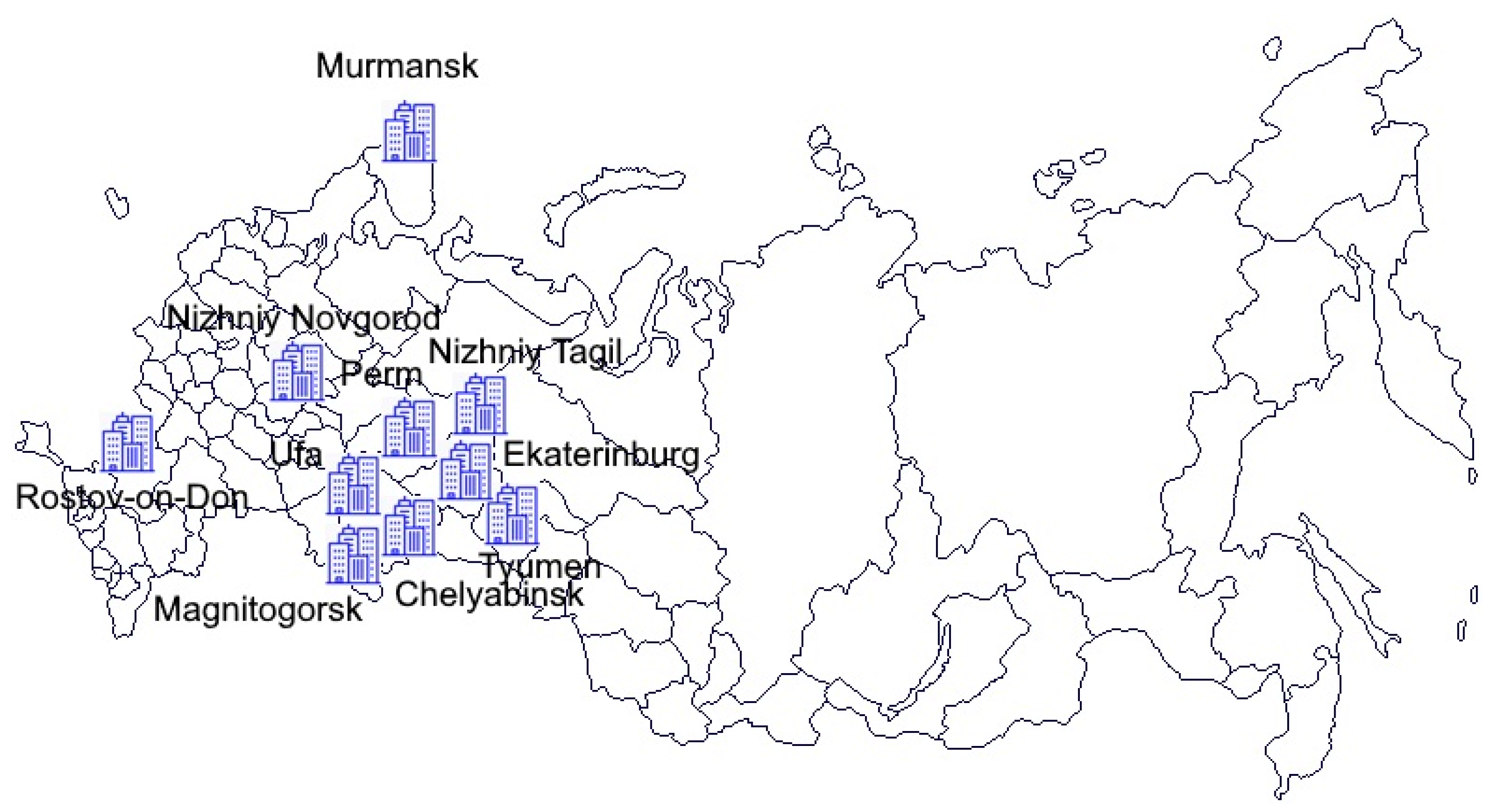
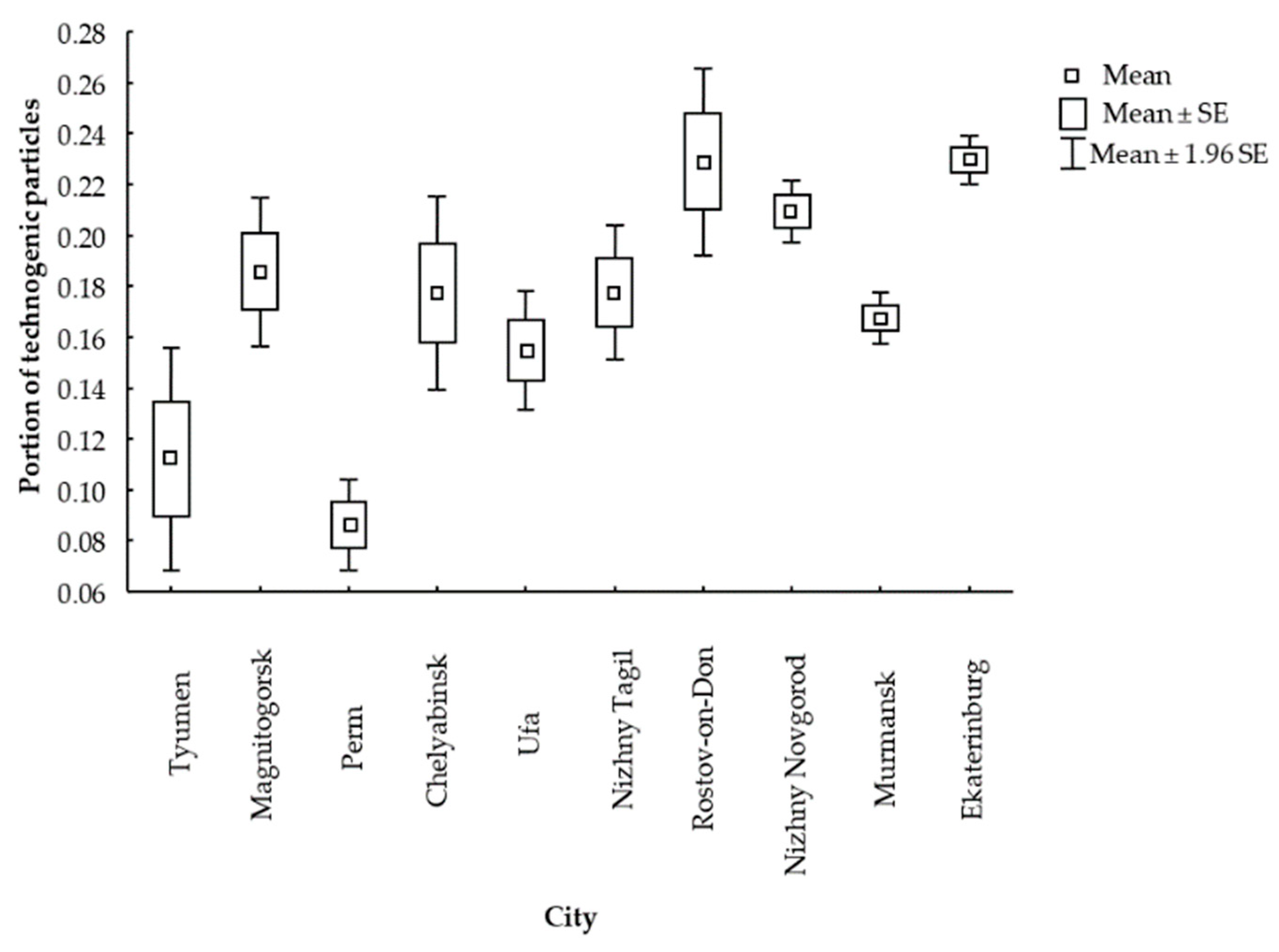
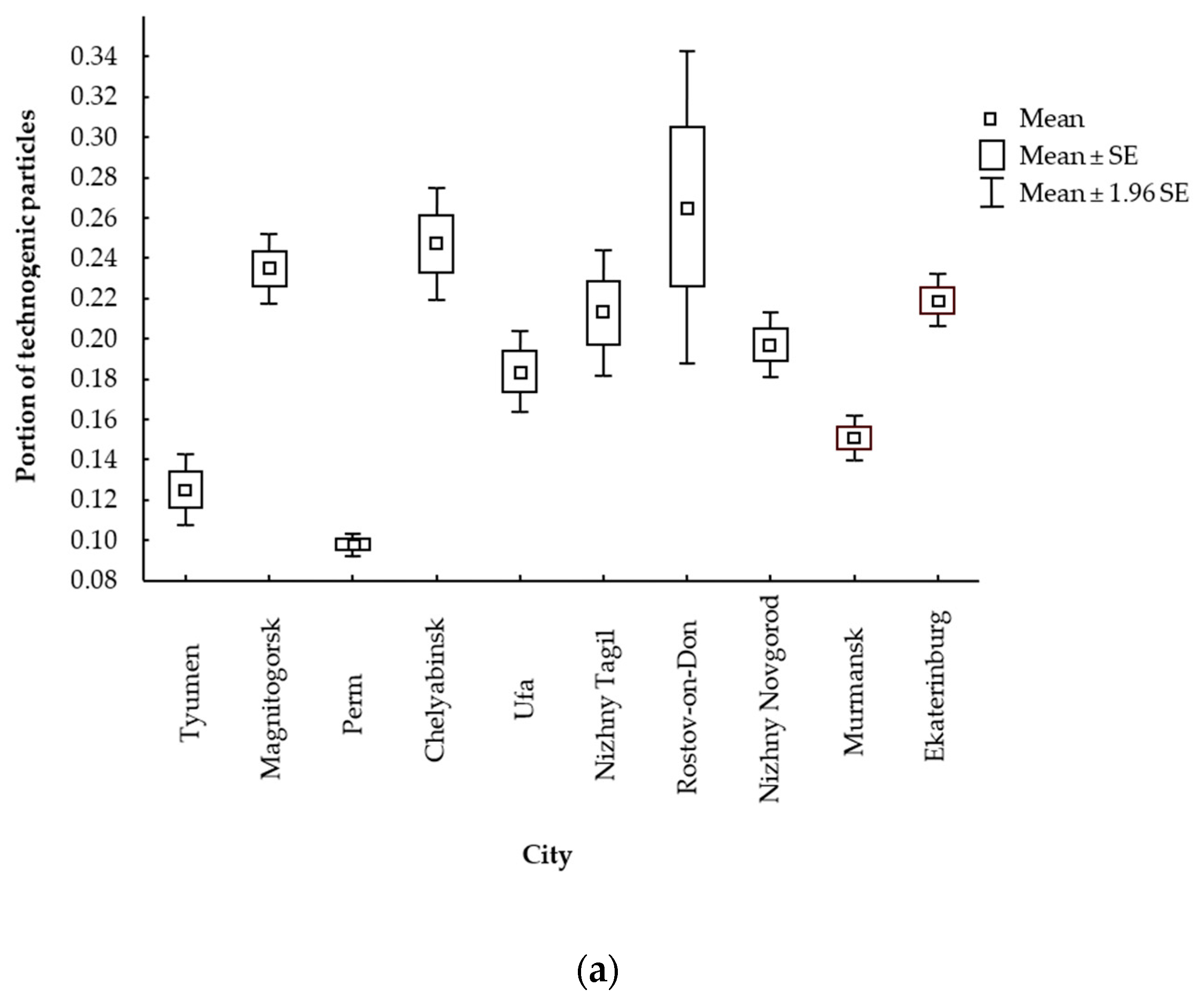
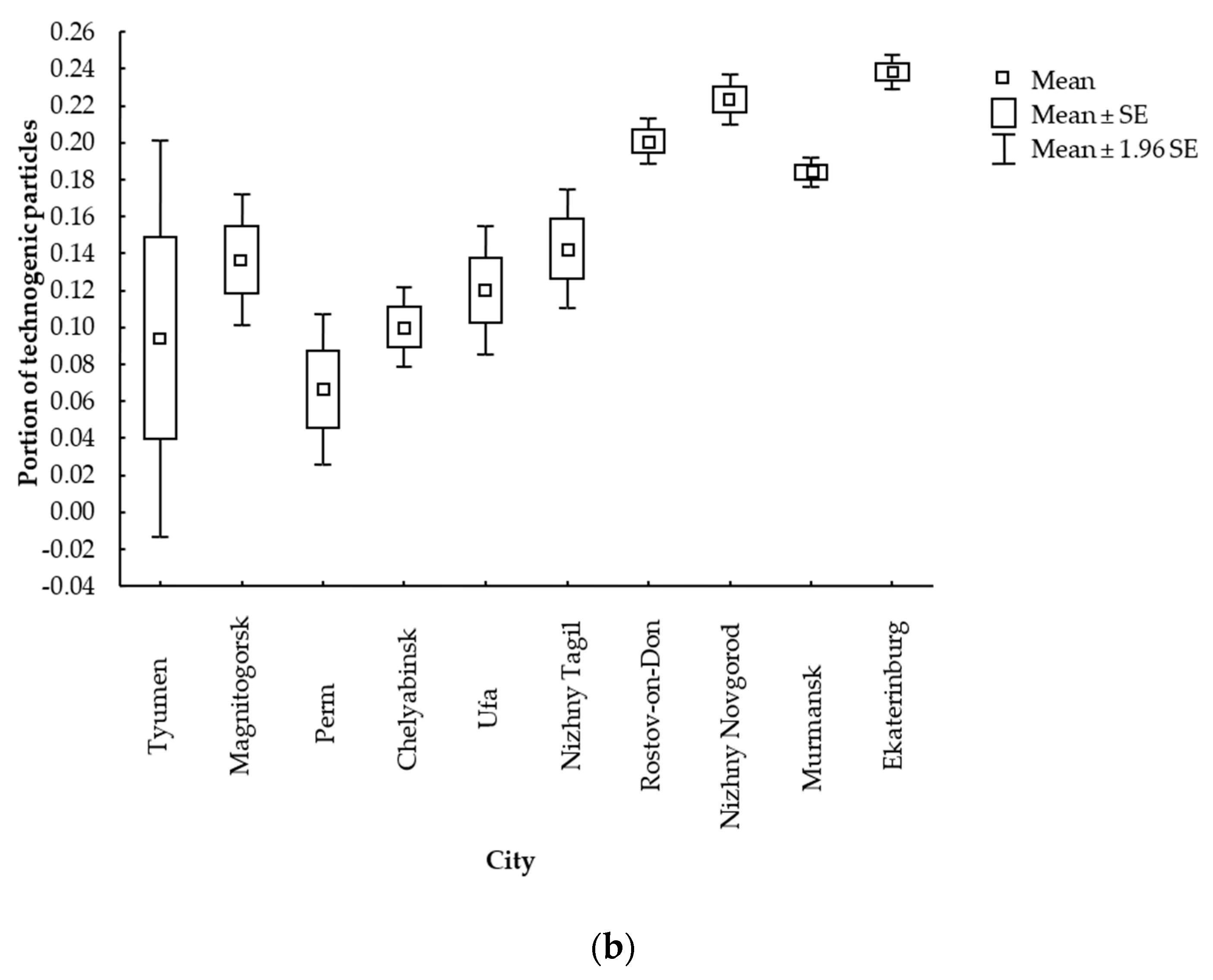
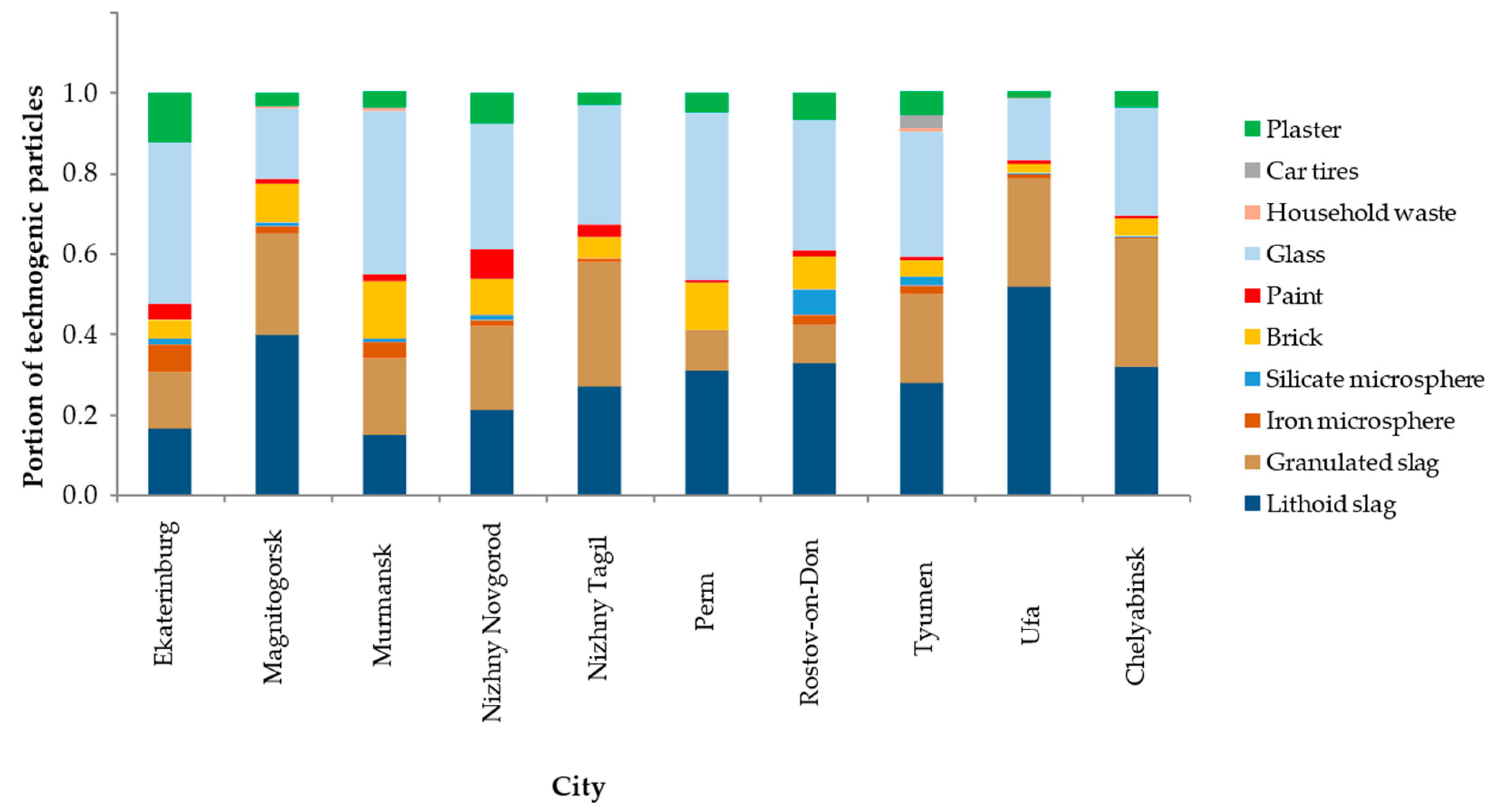
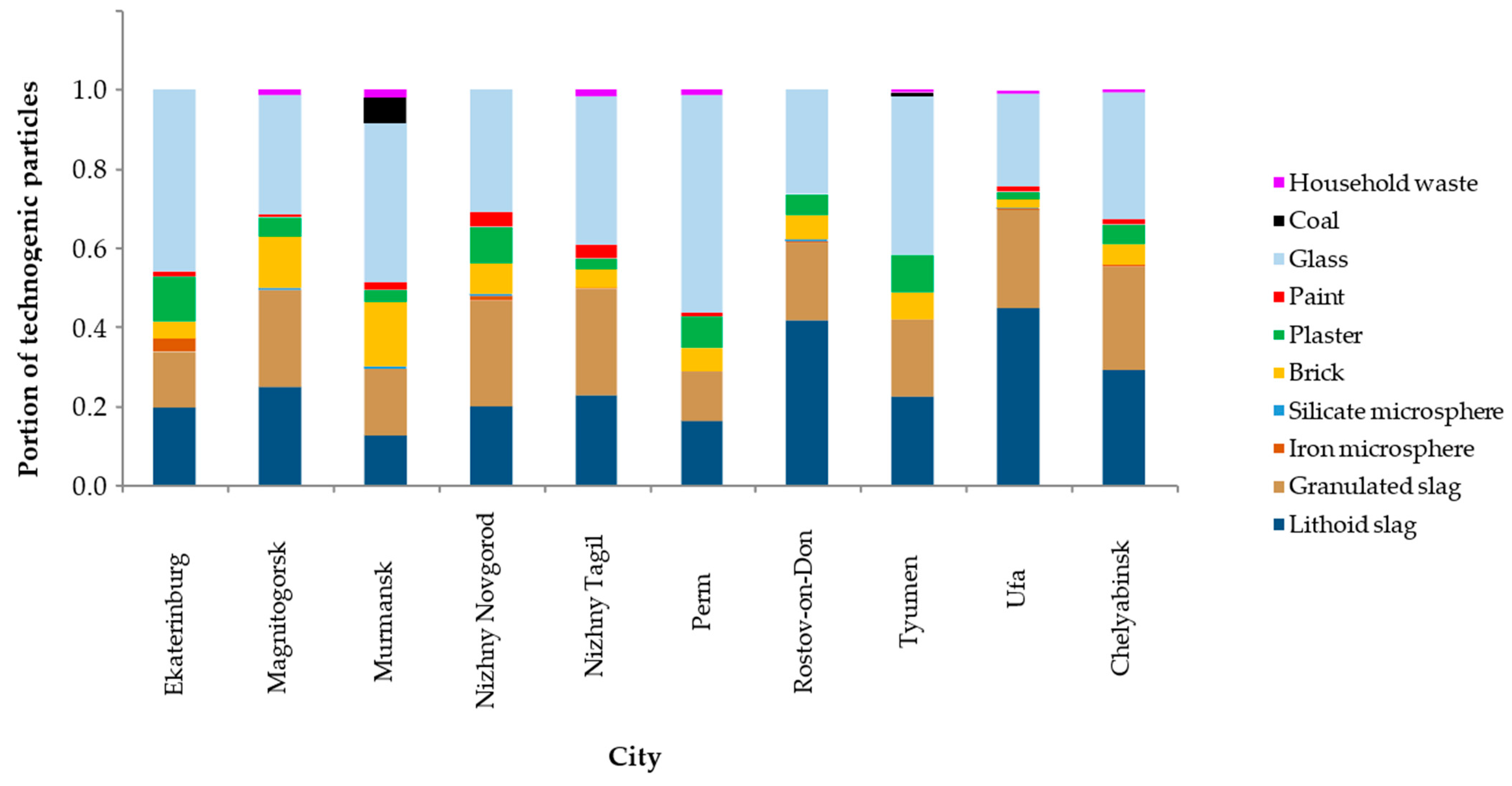
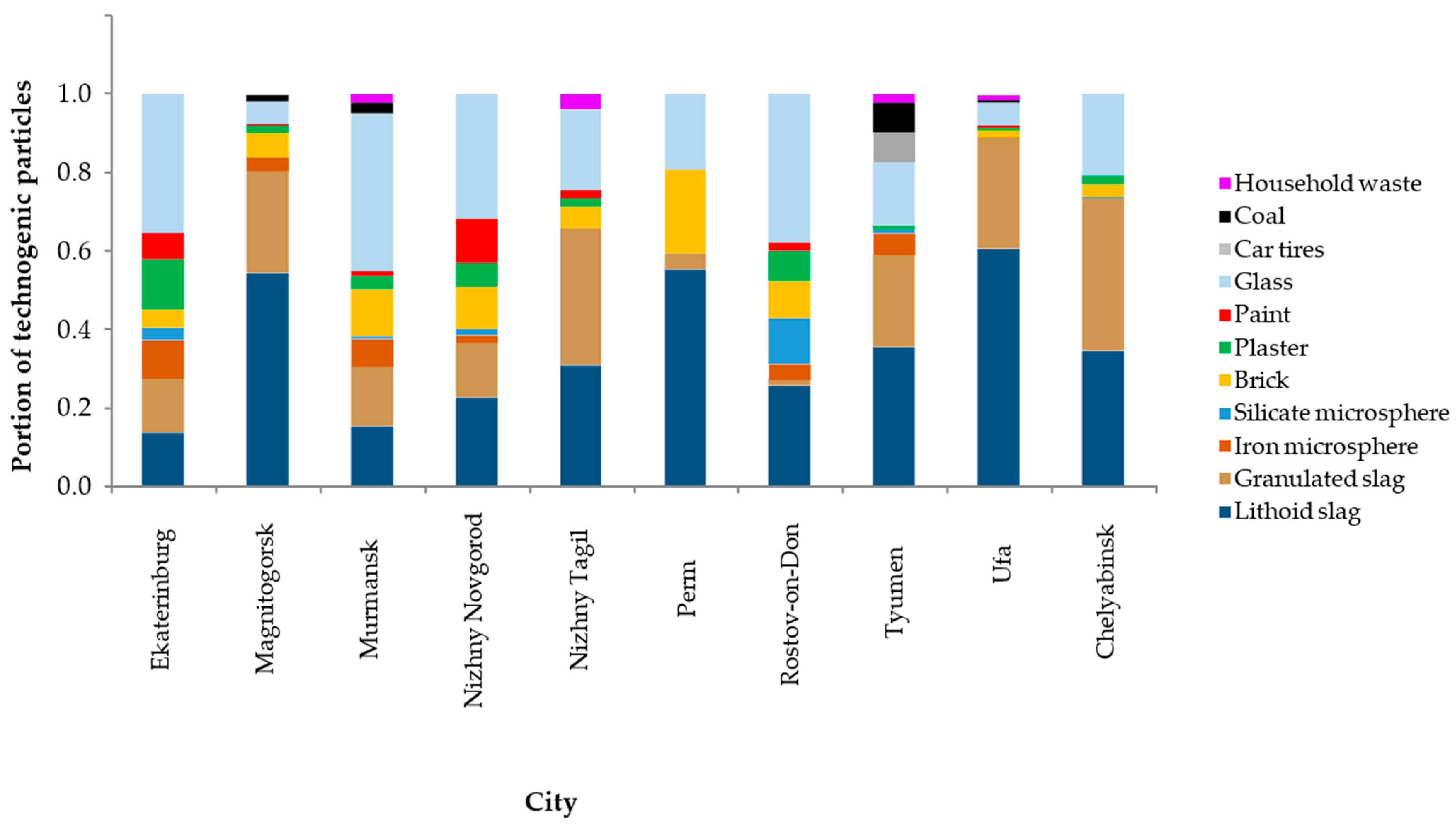
| City, Population, Million People/Cars per 1000 People/City Area (km2) | Geographic and Climatic Zone, Average Temperature, °C, Jan/Jul | Geological Features [47] | Main Industries |
|---|---|---|---|
| Ufa, 1.1/278/707.9 | Forest-steppe zone, temperate continental climate, −12.4/19.7 | Volga-Ural Anteclise, Verkhnekamsk basin; gypsum, anhydrite, sandstone, marl, siltstone, dolomite, Pre-Jurassic limestones; alluvium, colluvium, diluvium, sandstones, sandy loams, loams, Upper Pliocene and Holocene clays. | Oil processing, oil chemical industry, machinery |
| Perm, 1.007/237/803 | Forest zone, temperate continental climate, −12.8/18.6 | East of the European part of Russia, banks of the Kama River. Pre-Ural geomorphological zone, Kungurian stage, Irvinskaya and Fillipovskaya formations of the Pre-Jurassic: gypsum, sandstone, limestones, dolomites, marls; clays, loam and sandy loam of Holocene alluvial, eluvial and diluvial sediments. | Electric power industry, oil and gas processing, machinery, chemistry and petrochemistry, woodworking. |
| Tyumen, 0.77/363/698.5 | Western Siberia, forest taiga zone with waterlogged areas, temperate continental climate, −15/18.8 | West Siberian plain, Tyumen downwarp; diorites and gabbros of the Pre-Jurassicformations; loams, clays, silts and lake-alluvium of the Upper Pliocene and Holocene. | Oil processing, gas-fired power plants |
| Chelyabinsk, 1.2/269/530 | The South Urals, forest-steppe zone, temperate climate, −14.1/19.3 | East Urals uplift and West Side of West Siberian plate; granites, diorites, coals, limestones, sandstones, dolomitic limestones of the Pre-Jurassic formations; sands, siltstones, loams, alluvial sediments of floodplain terraces, pebbles, gravels, and eluvial-diluvial sediments of the Upper Pliocene and Holocene. | Ferrous and non-ferrous metallurgy, chemical industry, machinery, coal-fired power plants |
| Nizhniy Tagil, 0.36/240/297.5 | The Middle Urals, mountain-forest zone, temperate continental climate, −14.5/17.8 | Middle Urals, Tagil megazone; harzburgites, serpentinites, basalts, green schists, mica-quartz and graphite-quartz schists, diorites, gabbros, andesites, dacites of the Pre-Jurassic formations; eluvial and diluvial sediments, clays, sandy loams, alluvial sediments of floodplain terraces, pebbles, sands, and loams of the Upper Pliocene and Holocene. | Ferrous and nonferous metallurgy, coking, machinery, chemical industry, production of building materials |
| Magnitogorsk, 0.42/297/392.4 | The South Urals, steppe zone, harsh continental climate, −14.1/19.2 | South Urals, West Magnitogorsk zone; trachibasalts, trachiriolites, basalts, andesites, rhyodacites, lavas, and clastolavas of the Prejurasic formations; alluvial sediments of floodplains, clays, sands, peat, diluvial sediments, eluvial-diluvial sediments, and limes of the Upper Pliocene and Holocene. | Ferrous metallurgy, metal processing, gas-fired power plant |
| Nizhniy Novgorod, 1.3/276/460 | Broad-leaved forests, mixed forests and taiga zone, humid continental climate, −8.9/19.4 | Volga-Ural Anteclise, Pre-Quarternary clays with interbeds of siltstone, sand with gravel of sedimentary rocks, siltstone, loam, marl, gypsum, limestones, and dolomites; alluvial sediments, sands with gravel, loam, clay, eluvial and solifluction formations, sand, eluvial and diluvial Holocene formations. | Machinery, river shipping |
| Rostov-on-Don, 1.1/285/354 | Steppe zone, temperate continental climate, −3/23.4 | East European plate, Rostov ledge; sands, clays, gravel, and pebbles of the Lower Pliocene;limestones, shells, siltstones, and marls of the Upper Miocene; alluvium floodplain terraces, sands, pebbles, loams, sandy loam, eluvial and proluvial sediments of the Upper Pliocene and Holocene. | Machinery, river shipping, food industry |
| Murmansk, 303.8/321/154.4 | Arctic tundra zone, atlantic-arctic temperate climate, −10.1/12.8 | Murmansk megablock represented by Archean granitoids. Pyroxene diorites, tonalites-plagiogranites, magmatite-plagiogranite amphibole, metamorphosed gabbros, diorites, granites, gneisses, biotite amphibolites, magnetite quartzites of the Pre-Jurassic. Declivial marine sediments: sandy silts, mixed-grained sands. | Machinery, shipping, metalworking, food industry, coal-fired power plant |
| Ekaterinburg, 1.387/302/486 | The Middle Urals, forest zone, temperate continental climate, −12.6/19 | Middle Urals, low mountains and hilly plains along the Iset River. Serpentinites, granites, gabbro, diorites, tuffs, tuff sandstones, siliceous and carbonaceous-siliceous shale, quartzite of the Pre-Jurassic; eluvial and diluvial sediments, clays, loams, alluvial sediments of floodplain terraces of the Holocene. | Metal processing, machinery, gas-fired power plant |
| City | Number of Samples for Particle Size Analysis | Number of Obtained Particle Size Subsamples, in Which Technogenic Particles Were Selected * | |
|---|---|---|---|
| Fraction 0.1–0.25 mm | Fraction 0.25–1 mm | ||
| Ekaterinburg | 6 | 5 | 6 |
| Magnitogorsk | 10 | 10 | 10 |
| Murmansk | 10 | 10 | 10 |
| Nizhniy Novgorod | 8 | 8 | 7 |
| Nizhniy Tagil | 11 | 11 | 11 |
| Perm | 5 | 5 | 3 |
| Rostov-on-Don | 9 | 7 | 9 |
| Tyumen | 7 | 7 | 5 |
| Ufa | 12 | 12 | 10 |
| Chelyabinsk | 10 | 10 | 9 |
| City | Particle Size Fraction, mm | Kurtosis | Skewness | Coefficient of Variation, % | Min/Max |
|---|---|---|---|---|---|
| Tyumen | 0.1–0.25 | −0.79 | −0.87 | 19.01 | 0.09/0.15 |
| 0.25–1 | 4.51 | 2.09 | 129.91 | 0.01/0.31 | |
| Magnitogorsk | 0.1–0.25 | 0.30 | 1.08 | 11.94 | 0.21/0.29 |
| 0.25–1 | −1.11 | −0.62 | 41.88 | 0.04/0.2 | |
| Perm | 0.1–0.25 | 0.90 | 0.97 | 6.61 | 0.09/0.11 |
| 0.25–1 | 0.00 | 1.24 | 53.83 | 0.04/0.11 | |
| Chelyabinsk | 0.1–0.25 | 5.41 | 2.10 | 18.12 | 0.2/0.36 |
| 0.25–1 | 0.40 | −0.72 | 32.88 | 0.04/0.14 | |
| Ufa | 0.1–0.25 | 1.18 | −0.94 | 19.11 | 0.1/0.23 |
| 0.25–1 | 0.82 | 0.76 | 46.81 | 0.04/0.24 | |
| Nizhniy Tagil | 0.1–0.25 | 0.04 | 0.93 | 24.75 | 0.15/0.31 |
| 0.25–1 | −1.23 | −0.09 | 37.83 | 0.06/0.22 | |
| Rostov-on-Don | 0.1–0.25 | −0.80 | 1.22 | 39.36 | 0.19/0.43 |
| 0.25–1 | −1.19 | 0.29 | 9.33 | 0.17/0.23 | |
| Nizhniy Novgorod | 0.1–0.25 | 1.12 | −1.37 | 11.72 | 0.15/0.22 |
| 0.25–1 | 0.80 | −1.30 | 8.18 | 0.19/0.24 | |
| Murmansk | 0.1–0.25 | 0.02 | −0.62 | 11.66 | 0.12/0.18 |
| 0.25–1 | 3.25 | 1.38 | 6.85 | 0.17/0.21 | |
| Ekaterinburg | 0.1–0.25 | −2.01 | −0.40 | 6.75 | 0.2/0.24 |
| 0.25–1 | −2.52 | 0.15 | 4.82 | 0.23/0.25 |
| City | Curtosis | Skewness | Coefficient of Variation, % | Min/Max |
|---|---|---|---|---|
| Tyumen | 3.40 | 1.40 | 69.04 | 0.01/0.31 |
| Magnitogorsk | 0.15 | −0.78 | 35.91 | 0.04/0.29 |
| Perm | 0.67 | −1.38 | 29.70 | 0.04/0.11 |
| Chelyabinsk | −0.52 | 0.22 | 47.70 | 0.04/0.36 |
| Ufa | −0.73 | −0.41 | 35.72 | 0.04/0.24 |
| Nizhniy Tagil | 0.25 | 0.18 | 35.57 | 0.06/0.31 |
| Rostov-on-Don | 4.38 | 2.33 | 32.83 | 0.17/0.43 |
| Nizhniy Novgorod | 0.93 | −0.97 | 11.65 | 0.15/0.24 |
| Murmansk | 0.37 | −0.36 | 13.52 | 0.12/0.21 |
| Ekaterinburg | −0.04 | −0.43 | 6.94 | 0.2/0.25 |
| Type of Particle | Elements | Composition, Mass Portion of Element, % |
|---|---|---|
| Lithoid slag | major | O (31%), Si (21%), C (15%), Fe (10%), Ca (9%), Al (6%), |
| impurities | Mg (3%), Na (3%), K (2%) | |
| Granulated slag | major | O (39%), Si (18%), Fe (15%), Ca (9%), |
| impurities | Mg (4%), Al (4%), C (2%), Ti (1%), S (1%), K (1%) | |
| Iron microsphere (magnetic) | major | Fe (69%), O (24%), |
| impurities | Si (2%), Ca (1%) | |
| Silicate microsphere | major | O (39%), Si (23%), Ca (12%), Fe (8%), Mg (5%), |
| impurities | Al (4%), Na (2%), Cu (2%) | |
| Brick | major | O (35%), Si (22%), Fe (17%), Ca (11%), |
| impurities | K (3%), Al (3%), Na (2%), Ti (2%), C (2%) | |
| Paint | major | O (39%), Ca (15%), Fe (14%), Si (13%), Pb (5%), |
| impurities | Ti (4%), Mg (3%), Al (3%), K (1%), C (1%), Cr (1%) | |
| Glass | major | O (35%), Si (28%), Fe (9%), Ca (8%), |
| impurities | Al (4%), Cu (3%), Mg (2%), Na (2%), K (1%), Cr (1%) | |
| Plaster fragment | major | O (36%), Ca (29%), Si (11%), Fe (6%), C (6%), |
| impurities | Mg (3%), Al (3%), Na (1%), S (1%), K (1%), Cr (1%) | |
| White-coated plaster | major | Ti (46%), O (18%), Ca (15%), Cu (11%), |
| impurities | Ba (3%), Fe (1%), Al (1%), S (1%) | |
| Paint coated plaster | major | Ca (55%), O (30%), |
| impurities | Si (3%), Ti (3%), C (3%), Fe (2%), Al (1%), Pb (1%) |
| Type of Particle | Morphological Features | Size, mm | Possible Origin |
|---|---|---|---|
| Granulated slag | Glassy structure, shell-like breakage, poorly rounded, black, dark brown, dark green, grey, light yellow or colorless, transparent or translucent | 0.3–1 | Metallurgy |
| Lithoid (stone-like) slag | Stone-shaped particles, with a porous structure, crystallized, medium rounded, grey, dark brown, dark green, translucent or opaque | 0.3–1 | Metallurgy |
| Iron microsphere (magnetic) | Spheres, with a smooth or polygonal textured surface, steel-grey, often with thin films of iron oxides, opaque | 0.1–1 | Metallurgy |
| Silicate microsphere | Spheres, sometimes slightly flattened or deformed; the surface is corroded, with cavities and visible cracks; black, dark brown; opaque or colorless translucent with a strong glassy luster | 0.45–1 | Combustion of high ash raw material |
| Brick | Well or completely rounded debris (quartz, clay material, whitewash); red-brown, dark red with inclusions, opaque | 0.5–1 | Construction materials |
| Plaster | Thin, flattened particles, highly fragile; light grey, white, opaque, matt | 0.5–0.8 | Construction materials |
| Glass | Glassy, poorly or perfectly rounded; colorless, yellow, blue, green, transparent | 0.5–1 | Household waste |
| Paint | Thin, flattened, elastic particles; yellow, red, blue, green, with a matt or shiny surface | 0.25–1 | Construction materials |
| Car tires | Smooth particles, high elasticity; black, opaque, matt | 200–1000 | Automobile nonexhaust emissions |
Publisher’s Note: MDPI stays neutral with regard to jurisdictional claims in published maps and institutional affiliations. |
© 2021 by the authors. Licensee MDPI, Basel, Switzerland. This article is an open access article distributed under the terms and conditions of the Creative Commons Attribution (CC BY) license (https://creativecommons.org/licenses/by/4.0/).
Share and Cite
Seleznev, A.; Ilgasheva, E.; Yarmoshenko, I.; Malinovsky, G. Coarse Technogenic Material in Urban Surface Deposited Sediments (USDS). Atmosphere 2021, 12, 754. https://doi.org/10.3390/atmos12060754
Seleznev A, Ilgasheva E, Yarmoshenko I, Malinovsky G. Coarse Technogenic Material in Urban Surface Deposited Sediments (USDS). Atmosphere. 2021; 12(6):754. https://doi.org/10.3390/atmos12060754
Chicago/Turabian StyleSeleznev, Andrian, Ekaterina Ilgasheva, Ilia Yarmoshenko, and Georgy Malinovsky. 2021. "Coarse Technogenic Material in Urban Surface Deposited Sediments (USDS)" Atmosphere 12, no. 6: 754. https://doi.org/10.3390/atmos12060754
APA StyleSeleznev, A., Ilgasheva, E., Yarmoshenko, I., & Malinovsky, G. (2021). Coarse Technogenic Material in Urban Surface Deposited Sediments (USDS). Atmosphere, 12(6), 754. https://doi.org/10.3390/atmos12060754







